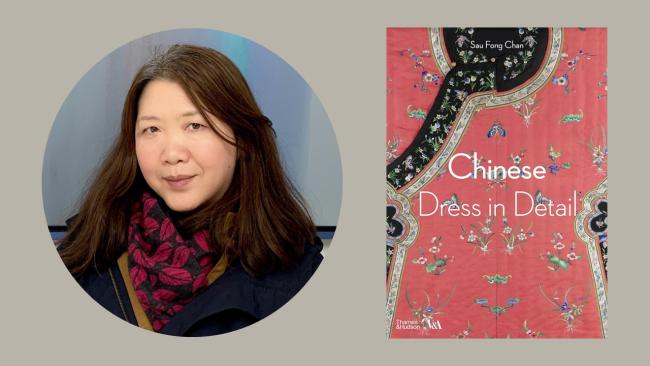
Chinese Dress in Detail
The China Forum seminar on Wednesday 24 January 2024 was delivered by Sau Fong Chan (Curator, Asia Department, Victoria and Albert Museum, London).
Sau Fong Chan’s seminar was based on her book Chinese Dress in Detail (published by Thames & Hudson in partnership with the V&A) which celebrates the ingenuity and craftsmanship of those who have designed and made garments in China over the centuries. It examines dress in both Imperial and Republican China (1911-1949), as well as in the era of Reform and Opening-up since the 1970s. The objects included in the book are all drawn from the V&A’s own collection. The V&A has been acquiring examples of Chinese dress since 1863. It holds one of the most important collections outside China, including not only ‘Imperial dress’, but also clothing worn by different ethnic, cultural, geographic and social groups in China. Sau Fong’s book is organised around a ‘head-to-toe’ approach. Her lecture examined not only garments, but also hats, hair decoration, and footwear. Selection of objects for inclusion in the book was guided by considerations of the artistic and historical context within which the objects were produced.
Sau Fong’s lecture paid close attention to the details of the objects selected, including not only the cloth, but also the thread, trimmings, embroidery, seams, buttons, sequins, and beads. She examined the circumstances in which the items of dress were produced and their social significance for the identity of the wearer. She analysed the international dress linkages in both traditional and modern China, including sourcing materials from abroad and the spread of technology from the West into China. Sau Fong examined the long-term influence of foreign fashion upon China, stretching from Sogdian culture from Central Asia during the Tang Dynasty (618-907AD), to the ‘English collar’ in the 1910s and ‘waisted’ dresses in the 1950s, to the opening up of China to international fashion under Deng Xiaoping, which was heralded by Pierre Cardin’s 1979 fashion show in Beijing. Sau Fong drew attention also to dress used by ordinary people, including work clothing, caps and straw footwear. Her lecture concluded with an examination of the current interest in ‘Hanfu’ clothing among ‘Generation Z’ and the under-stated style of black silk among intellectuals, musicians and artists.
Issues discussed in the Q&A included: the interaction between Chinese and Western clothing styles; the socio-cultural impact of Western clothing upon China over the past forty years, such as Pierre Cardin’s unisex goods displayed in Bejing’s wangfujing street in 1979; clothing as an expression of identity and a social marker; the extent to which wearing hanfu dress is spontaneous or encouraged by the government as part of ‘national rejuvenation’; China’s influence upon European fabrics during the Han Dynasty, as a result of silk export from China along the Silk Road; the transfer of embroidery skills from China to Europe and the transfer of European crocheting techniques (including crocheted buttons) to China through Christian missionaries; the role of the button market in Wenzhou in Chinese economic reforms in the early 1980s; Yangzhou’s artificial flower industry in the 18th century; the footwear of ordinary people in China in the late 19th and early 20th centuries.
Sau Fong Chan is a curator in the Asia Department at the Victoria and Albert Museum, London and a specialist in Chinese textiles and dress. She co-curated the exhibitions Rabindranath Tagore: Poet and Painter and Silver from the Malay World, and has contributed to several V&A publications. Her latest book is Chinese Dress in Detail (London and New York 2023).





